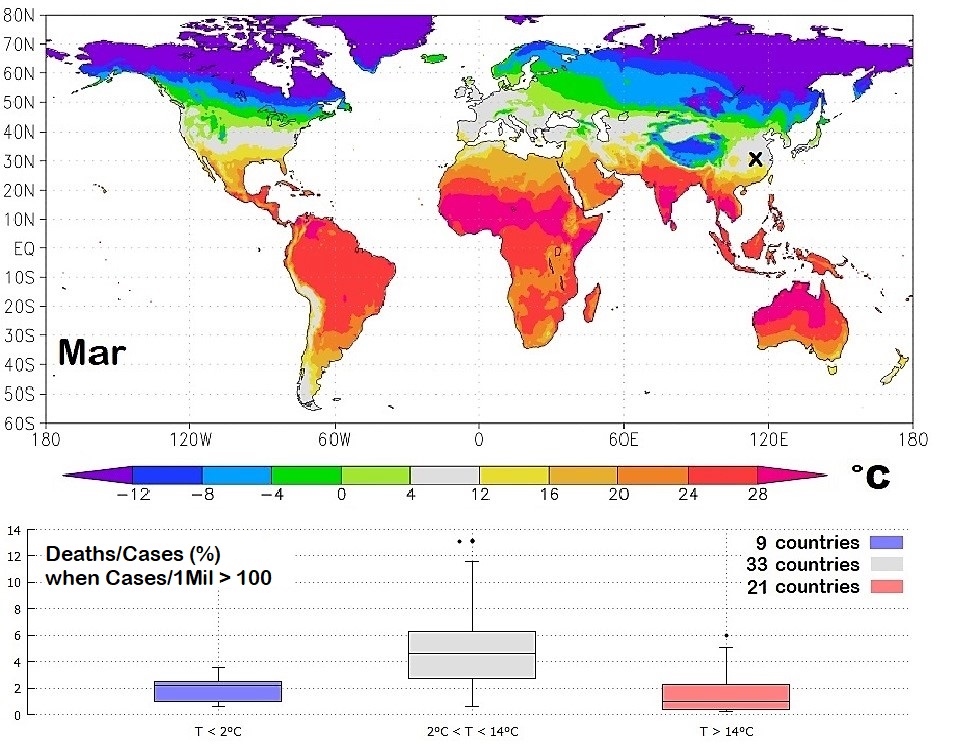Relazione tra condizioni meteo e contagi di COVID-19
Distribution of the SARS-CoV-2 Pandemic and Its Monthly Forecast Based on Seasonal Climate Patterns.
Questo documento esamina se la pandemia CoronaVirus 2 (SARS-CoV-2) della sindrome respiratoria acuta grave avrebbe potuto essere favorita da specifiche condizioni meteorologiche e da altri fattori. Si scopre che il clima invernale del 2020 nella regione di Wuhan (Hubei, Cina centrale) - dove il virus è scoppiato per la prima volta in dicembre e si è diffuso ampiamente da gennaio a febbraio 2020 - era sorprendentemente simile a quello delle province del Nord Italia di Milano, Brescia e Bergamo, dove la pandemia è scoppiata da febbraio a marzo. L'analisi statistica è stata estesa per coprire gli Stati Uniti d'America, che hanno superato l'Italia e la Cina come il paese con il maggior numero di casi confermati di Malattia COronaVIRus 19 (COVID-19), e poi al mondo intero. I modelli di correlazione trovati suggeriscono che la letalità COVID-19 peggiora significativamente (4 volte in media) sotto le temperature atmosferiche tra i 4 e i 12 gradi centigradi e l'umidità relativa tra il 60% e l'80%. Sono stati studiati anche possibili co-fattori come l'età mediana della popolazione e l'inquinamento atmosferico, suggerendo un'importante influenza del primo, ma non dei secondi, almeno su scala sinottica. Sulla base di questi risultati, sono state generate mappe mondiali isotermiche specifiche per individuare, mese per mese, le regioni del mondo che condividono intervalli di temperatura simili. Da febbraio a marzo, la zona di isotermia di 4-12 gradi si estendeva principalmente dalla Cina centrale verso Iran, Turchia, Europa del Mediterraneo occidentale (Italia, Spagna e Francia) fino allo Stato Unito d'America, coincidendo in modo ottimale con le regioni geografiche più colpite dalla pandemia da febbraio a marzo. Si prevede che in primavera, quando il clima si alcaldo, la pandemia probabilmente peggiorerà nelle regioni settentrionali (Regno Unito, Germania, Europa orientale, Russia e Nord America) mentre la situazione probabilmente migliorerà nelle regioni meridionali (Italia e Spagna). Tuttavia, in autunno, la pandemia potrebbe tornare e colpire nuovamente le stesse regioni. La zona tropicale e l'intero emisfero meridionale, ma nelle regioni meridionali più fredde, potrebbero evitare una forte pandemia a causa del clima sufficientemente caldo durante tutto l'anno e a causa dell'età media inferiore della loro popolazione. Le mappe interattive di Google-Earth-Pro che coprono il mondo intero sono fornite come file supplementari.
https://www.unina.it/-/22121560-condizioni-meteo-climatiche-e-contagi-di-covid-19
http://www.meteoweb.eu/2020/05/coronavirus-meteo-caldo-letalita/1435300/



